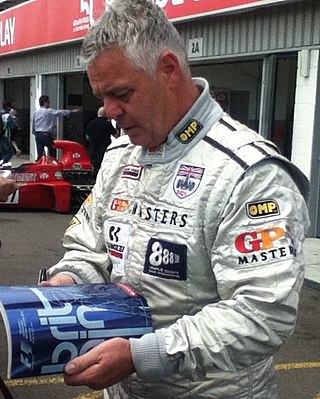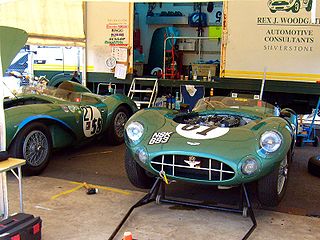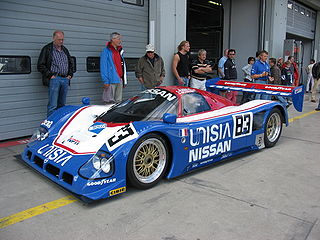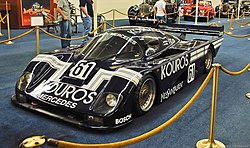
The European Le Mans Series is a European sports car racing endurance series inspired by the 24 Hours of Le Mans race and organized by the Automobile Club de l'Ouest (ACO). The European Le Mans Series is similar to the former American Le Mans Series (ALMS) based in the United States and Canada that was running with ACO and IMSA between 1999 and 2013. ELMS team champions and runners-up receive an automatic entry to the following year's 24 Hours of Le Mans. Originally titled the Le Mans Endurance Series before becoming simply the Le Mans Series in 2006, the series was renamed once more in 2012, reusing a name previously utilized by IMSA in 2001.

The Sauber C9 is a Group C prototype race car introduced in 1987 as a continuation of the partnership between Sauber as a constructor and Mercedes-Benz as an engine builder for the World Sportscar Championship. The C9 replaced the Sauber C8.

The World Sportscar Championship was the world series run for sports car racing by the FIA from 1953 to 1992.

The Toyota TS010 was a Group C racing car built by Toyota for the Sportscar World Championship, All Japan Sports Prototype Championship, and the 24 Hours of Le Mans.
Max Welti is a former Swiss racing driver, Sauber's first team manager and thus double winner of the 24 Hours of Le Mans as well as two-time sports car world champion with Sauber Mercedes. Five years later, he wins the 24 Hours of Le Mans for a second time with Porsche as the responsible race director. He then returns to Sauber as overall manager of the Sauber Formula One operation. In 2000 Welti becomes CEO of the European silhouette touring car racing series "V8STAR" before becoming team owner of A1 A1 Team Switzerland in 2005. As an international motorsport strategist and consultant, Welti nowadays works for OEMs, promoters and organisers.

The Mercedes-Benz C11 is a Group C prototype race car introduced for the 1990 World Sports-Prototype Championship. Built by Sauber as a successor to the Sauber C9, the C11 used the same Mercedes-Benz M119 5.0L twin turbo V8. It was the first time that Mercedes-Benz chose to put their name on the car, instead of simply using Sauber.

The McLaren F1 GTR is the racing variant of the McLaren F1 sports car first produced in 1995 for grand touring style racing, such as the BPR Global GT Series, FIA GT Championship, JGTC, and British GT Championship. It was powered by the naturally aspirated BMW S70/2 V12 engine. It is most famous for its overall victory at the 1995 24 Hours of Le Mans where it won against faster purpose-built prototypes in very wet conditions. The F1 GTR raced internationally until 2005 when the final race chassis was retired.

The 1992 Sportscar World Championship season was the 40th and final season of FIA World Sportscar Championship motor racing. It featured the 1992 FIA Sportscar World Championship, which was contested over a six race series which ran from 26 April to 18 October 1992. The championship was open to Group C Sportscars.

The Mercedes-Benz C291 was a sports-prototype racing car introduced for the 1991 World Sportscar Championship season. It was Mercedes-Benz’ final car in the Group C category.

The Mercedes-Benz C292 was a stillborn Group C prototype race car intended for the 1992 World Sportscar Championship season as an evolution of the Mercedes-Benz C291, but never raced due to Mercedes-Benz withdrawing from sportscar racing after a dismal 1991 season.

The Nissan R391 is a prototype racing car built by Nissan and their motorsports counterpart Nismo for competition at the 1999 24 Hours of Le Mans. It was a replacement for the R390 GT1, which was no longer legal in its production-based class.

The Aston Martin DBR1 was a sports racing car built by Aston Martin starting in 1956, intended for the World Sportscar Championship as well as non-championship sportscar races at the time. It is most famous as the victor of the 1959 24 Hours of Le Mans, Aston Martin's only outright victory at the endurance classic. It is one of only three cars in the 1950s to win both the World Sports Car Championship and Le Mans 24 Hours in the same year. In addition the six World Sports Car Championship victories was a record for any car in the 1950s and remained a record in the championship until surpassed by the Ferrari 250TR. The three consecutive triumphs in 1959 at the Nürburgring, Le Mans and the Tourist Trophy equalled the record set by the Ferrari 250TR with its three consecutive victories at the start of the 1958 season.
Throughout its long history, Mercedes-Benz has been involved in a range of successful motorsport activities, including sportscar racing, touring car racing, Grand Prix racing, and rallying. It is currently active in GT racing, and Formula One.
The Sauber C7 was a Group C prototype race car built by Swiss manufacturer Sauber for competition in the World Sportscar Championship.

The Sauber SHS C6 was a Group C prototype racing car built by Swiss manufacturer Sauber and engineering firm Seger & Hoffman, intended for competition in the World Endurance Championship and Deutsche Rennsport Meisterschaft series. Seger & Hoffman left the project later in 1982, leaving the car completely under Sauber's control.

The BMW V12 LM was a racing car built for sports car racing in 1998. The car was built using a combination of WilliamsF1 chassis engineering and construction and a BMW powerplant. The car was a predecessor to the BMW V12 LMR, which debuted in 1999.

The Nissan R90C was a platform used for Group C racing cars built in 1990 by Nissan Motors for competition in World Sportscar Championship (WSC) based in Europe and the All Japan Sports Prototype Championship (JSPC). The cars based on the basic R90C platform would compete until 1993 before Nissan chose to withdraw from sports car racing, not returning until 1997. It won three JSPC championships and several significant endurance races during its career.

Brun Motorsport GmbH was a Swiss auto racing team founded by driver Walter Brun in 1983. They competed as a Porsche privateer team in sports car racing for their entire existence, running in a multitude of international championships. They notably won the World Sportscar Championship in 1986 and later became a full-fledged chassis constructor. Brun was also briefly part of the EuroBrun Formula One team from 1988 to 1990. The team was eventually dissolved in 1992.

The 1986 ADAC Kouros 1000 km Nürburgring was the seventh round of the 1986 World Sports-Prototype Championship. It took place at the Nürburgring, West Germany on August 24, 1986.

The CLM P1/01, renamed ENSO CLM P1/01 in 2017, is a sports prototype racing car built for Lotus Racing in 2014. The Lotus team entered the last five rounds of the World Endurance championship in 2014, but later took name as the Austrian based team ByKolles Racing. It is designed to meet the 2014 LMP1-L regulations for Le Mans Prototypes in the FIA World Endurance Championship as well as at the 24 Hours of Le Mans. The P1/01 debuted at the 2014 6 Hours of Circuit of the Americas, round four of the FIA World Endurance Championship.

















